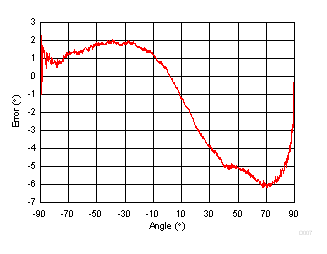SLYA036B July 2018 – November 2021 DRV5053 , DRV5053-Q1 , DRV5055 , DRV5055-Q1 , DRV5056 , DRV5056-Q1 , DRV5057 , DRV5057-Q1
- Trademarks
- 1Introduction
- 2Overview
- 3Device Descriptions
-
4Methods
- 4.1 Uncalibrated Implementations
- 4.2 Peak Calibrated Implementations
- 4.3 Lookup Table Calibration Implementations
- 4.4 Peak Calibrated Plus Lookup Table Hybrid
- 5References
- 6Revision History
4.2.2.3 Accuracy
The output from the arcsin function has a swing of ±90°. However, the accuracy generally decreases when the angle is too close to 90° or –90° because there is not much variance in the output voltage for those regions. In general, the accuracy is usually within 8° peak-to-peak when operating at a swing of ≈±80°, based on datasheet parameters and experimental data taken with the DRV5055. Figure 4-11 shows an example of a possible error curve for this setup.
 Figure 4-11 One Sensor Peak Calibrated Error
Figure 4-11 One Sensor Peak Calibrated Error